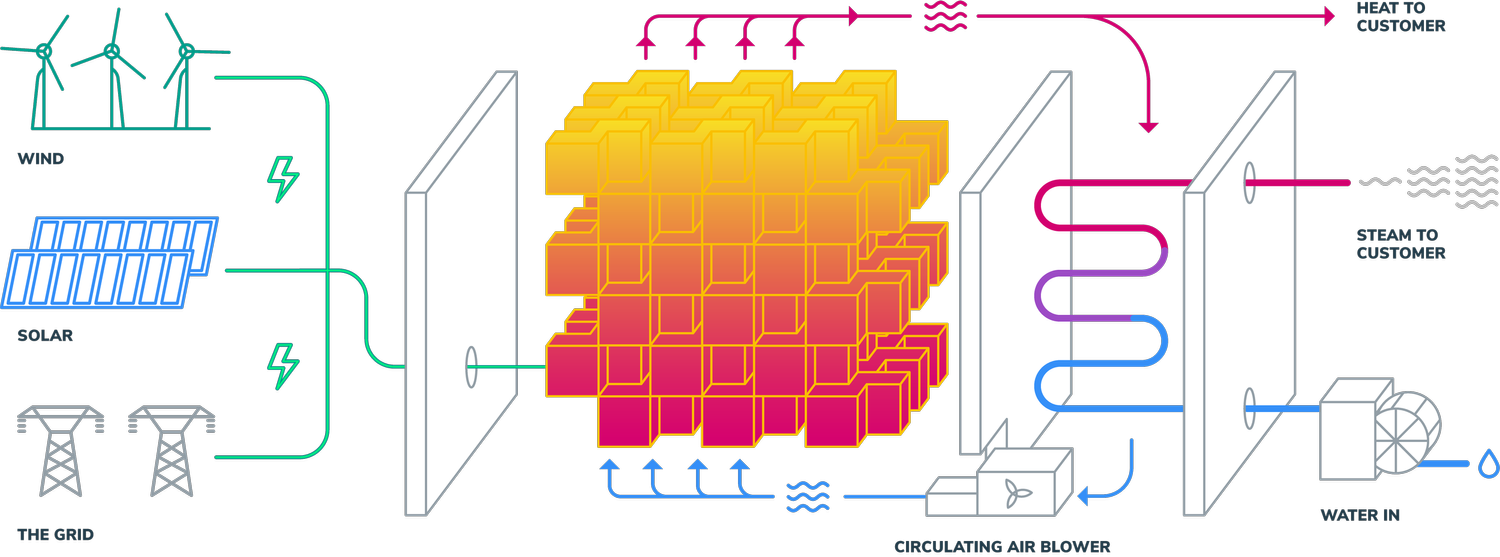From pv magazine USA
Rondo Energy, developer of the Rondo Heat Battery, announced it has partnered with Siam Cement Group to expand its factory to a 90 GWh capacity. The Thailand facility currently produces 2.4 GWh of industrial heat batteries and is planned to be expanded to the largest battery factory in the world.
The Bill Gates-backed company developed its heat battery as a way to decarbonize the industrial sector. Rondo’s battery, called the “brick toaster,” is made of readily available materials like oxygen, silicon, aluminum, and iron. The battery stores electric power as heat in refractory brick, a technology that has been used in industrial heat storage for centuries.
The heat batteries transform intermittent wind and solar power into the continuous high-temperature and low-cost heat that the industry demands. This planned production expansion is expected to support a wide range of industries, from mining and metals to fuels to food production, at facilities around the world.
“Electric thermal energy storage can play a useful role in addressing the needs of the industrial sector, which has been slow to decarbonize. And, from an energy security standpoint, it is worth noting that this technology avoids the use of scarce and expensive materials,” said Pavel Molchanov, energy analyst at Raymond James.
The batteries store and dispatch heat without the use of combustibles, critical minerals, or liquids. With a Rondo Heat battery, solar and wind can deliver continuous zero-carbon industrial heat at a lower cost than fossil fuels, said the company.
The batteries can store more than 1 MWh per square meter, a high level of density that preserves area use at industrial facilities. Rondo said the batteries can be integrated into existing process heating equipment, allowing for significant emissions reductions without the need for a factory overhaul. The batteries are expected to operate for 40 years or more with no performance degradation.

Heavy industrial processes have proven to be one of the most difficult sectors to decarbonize and account for about 24% of global emissions, according to Our World in Data. The 90 GWh of planned capacity is expected to result in 12 million tons of carbon dioxide emissions abatement annually, equivalent to removing over 4 million gas-powered vehicles from the road each year.
Popular content
Rondo said its batteries offer continuous power with a 95% annual capacity while operating on input power as low as 15% capacity factor, or four hours of dispatchable power generation per day.
“Our studies of customer facilities are showing 50% to 90% reductions in emissions and reductions in operating costs of 30% or more,” said Jeremey Keller, senior vice president of Rondo Energy.
In early 2022, Rondo Energy announced the closing of a $22 million Series A funding round to support its technology, a renewable energy heat battery aimed at reducing the carbon impact of industrial processes. The funding round was led by Breakthrough Energy Ventures and Energy Impact Partners.
“Over the last few years we’ve seen validation of our founding vision,” said John O’Donnell, chief executive officer, Rondo Energy. “Decarbonizing industrial heat is a trillion-dollar market requiring far more storage than the electric grid. The technology is here now. The demand is here now. This planned expansion means that the capacity is here now as well.”
This content is protected by copyright and may not be reused. If you want to cooperate with us and would like to reuse some of our content, please contact: editors@pv-magazine.com.



By submitting this form you agree to pv magazine using your data for the purposes of publishing your comment.
Your personal data will only be disclosed or otherwise transmitted to third parties for the purposes of spam filtering or if this is necessary for technical maintenance of the website. Any other transfer to third parties will not take place unless this is justified on the basis of applicable data protection regulations or if pv magazine is legally obliged to do so.
You may revoke this consent at any time with effect for the future, in which case your personal data will be deleted immediately. Otherwise, your data will be deleted if pv magazine has processed your request or the purpose of data storage is fulfilled.
Further information on data privacy can be found in our Data Protection Policy.